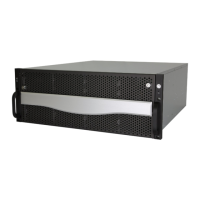
Do you have a question about the Qsan AegisSAN Q500 Series and is the answer not in the manual?
| Model | AegisSAN Q500 Series |
|---|---|
| Category | Storage |
| RAID Levels | 0, 1, 5, 6, 10, 50, 60 |
| Controller | Dual Active-Active Controllers |
| Form Factor | Rackmount |
| Supported Protocols | iSCSI, Fibre Channel |
| Processor | Intel Xeon |
| Drive Types | SAS, SATA |
| Operating System | Qsan SANOS |
| Power Supply | Dual power supply |
| Cooling | Hot-swappable cooling fans |
Introduces Qsan storage systems and available chassis types.
Provides basic information about the hardware components of the systems.
Defines RAID as Redundant Array of Independent Disks and its basic idea.
Describes various RAID levels with data protection, availability, and performance details.
Defines iSCSI as a protocol for linking storage devices over IP networks.
Lists items to prepare before starting the installation process.
Provides instructions for installing and deploying AegisSAN Q500 Series storage systems.
Describes methods for managing the storage system via console or remote access.
Explains how to access and use the Qsan storage system's web-based graphical interface.
Guides through setting up array, network, and volume creation.
Helps determine possibilities and sizes for RAID levels using free drives.
Covers system settings, network, login, email, and log/alert configurations.
Used to set the system name and date.
Used to view MAC address and change basic network settings.
Controls system access, auto logout, and user/admin password management.
Details network setup, entity, iSNS, nodes, sessions, CHAP, and Fibre Channel settings.
Changes IP addresses of iSCSI data ports and configures bonding.
Views fibre channel information and changes link speed for FC ports.
Shows the status of hard drives and allows disk health checks and management.
Provides tools to create, modify, delete, and view RAID group status.
Allows creation, modification, deletion, and viewing of virtual disk status.
Provides logs of system events, allowing filtering by INFO, WARNING, or ERROR levels.
Used for upgrading firmware, changing operation mode, and activating SSD caching license.
Resets system configurations to factory default settings.
Provides functions to reboot or shutdown the system, ensuring data protection.
Rebuilds degraded RAID groups using spare disks, focusing on changed partitions.
Introduces thin provisioning for efficient storage allocation and cost reduction.
Highlights advantages like reduced initial disk purchase and better utilization.
Compares Fat and Thin provisioning, focusing on 'write on demand'.
Covers threshold settings and capacity policies for managing storage usage.
Explains how to expand Qsan storage space by adding JBOD expansion systems.
Details connecting expansion systems with SAS connections and viewing hardware status.
Provides procedures for upgrading JBOD firmware.
Explains MPIO and MC/S features for redundant paths in iSCSI initiator.
Explains link aggregation for increased bandwidth and fault tolerance.
Details Link Aggregation Control Protocol for bundling physical ports into a logical channel.
Describes using multiple iSCSI data ports in parallel to increase link speed.
Explains dual controller support for redundancy, master/slave roles, and status indicators.
Details performing I/O on dual controllers using MPIO for stable connections.
Captures instant data states using Copy-on-Write for backup and rollback.
Guides through setting snapshot space and taking a snapshot of a virtual disk.
Guides on setting up MPIO for replication tasks to add path redundancy.
Guides on setting up MC/S for multiple connections per session in replication tasks.